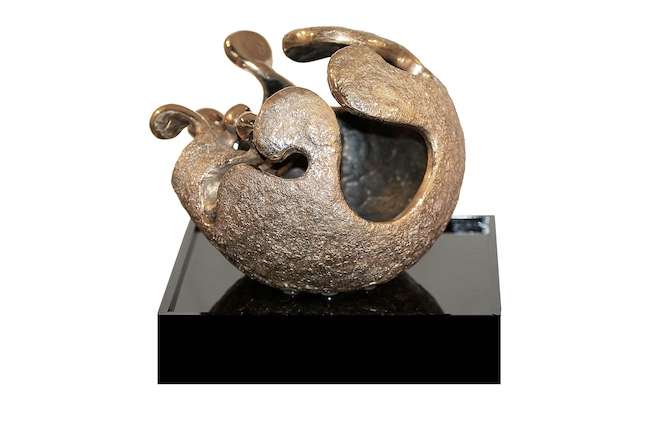Gli artisti contemporanei hanno la tendenza a esplorare l’interiorità e le profondità dell’animo con un approccio intimista, esistenziale, ben diverso dalla necessità di lasciar fuoriuscire le emozioni in maniere impetuosa e travolgente che contraddistingueva i maestri del secolo precedente, quando la necessità di affermare la predominanza delle sensazioni sulla forma divenne impellente. Nel periodo attuale invece, quell’urgenza è stata superata da una consapevolezza di libertà espressiva che appartiene al nostro secolo e dunque la manifestazione artistica è parimenti intensa ma più misurata, più cosciente ed equilibrata. La protagonista di oggi esprime con spontaneità il proprio concetto del vivere attuale, dell’interscambio e della forza empatica attraverso la scultura.
Le profonde modificazioni stilistiche che attraversarono il panorama artistico della prima metà del Ventesimo secolo, rompendo spesso nettamente gli schemi del passato, non potevano non coinvolgere anche la scultura che a sua volta si è legata alle varie correnti che si sono susseguite lasciando un profondo segno nel modo di intendere e di fare arte, sebbene i maggiori esponenti del mondo scultoreo abbiano saputo mantenere una forte originalità, di fatto reinterpretando le linee guida più incisive della pittura. A partire dal Primitivismo gli artisti cominciarono a esplorare un modo differente di scolpire, prendendo spunto dalle maschere e dalle icone africane e asiatiche che costituirono la base del Cubismo di Pablo Picasso ma anche delle sculture di Amedeo Modigliani; anche il Futurismo ha avuto le sue icone plastiche con Umberto Boccioni la cui Forme uniche nella continuità dello spazio resta indissolubilmente identificata come simbolo della corrente artistica da lui rappresentata. E ancora il Surrealismo ebbe in Max Ernst un originale interprete, autore di grandi figure di forma tendenzialmente rettangolare in cui il mondo dell’incubo, dell’inquietante, veniva raccontato e posto in dialogo con l’ambiente esterno. Con l’avvento dell’Astrattismo, con la rinuncia quindi a tutto ciò che era conoscibile con lo sguardo, il mondo della scultura andò verso una personalizzazione assoluta sulla base del sentire e dell’intendere, rifiutando la forma per entrare nella sfera dell’intuibile, del percepibile o del concetto di ciascun artista; questo è il motivo per cui i tre maggiori rappresentanti dell’Astrattismo scultoreo appaiono tanto differenti tra loro. La stilizzazione della forma compiuta da Constantin Bràncusi, le cui immagini sembrano in qualche modo raccontare l’esigenza di ridurre all’essenziale l’apparire per andare alla ricerca dell’essere, di quel contatto con l’interiorità senza essere distratti da tutto ciò che circonda l’uomo e che lo allontana dalla sostanza, esprime una ricerca stilistica di perfezione e purezza della forma si lega alla sua filosofia, al suo sguardo nei confronti del mondo in cui viveva. Tanto quanto Henry Moore svela invece un’esigenza armonica, diviso tra approccio più figurativo e astratto, sulla base delle sensazioni che desidera rappresentare, in cui la figura tondeggiante, morbida e in sintonia con l’ambiente circostante sembra suggerire una ricerca, o meglio un tentativo di mediazione tra interiorità ed esteriorità che, nel suo caso, non allontana dalle emozioni e dai sentimenti anzi, sembra invece accoglierli e proteggerli all’interno della sua apparenza estetica. L’artista italiana Tiziana Mucchiani-Farah, ormai da anni residente in Svizzera, che si firma MuiT, riprende il tema delle forme tondeggianti di Moore personalizzandole in maniera del tutto originale, ponendole al centro della sua ricerca scultorea proprio per sottolineare la consapevolezza della circolarità dell’esistenza, di quella coscienza di quanto in fondo ciascuna esperienza abbia un senso specifico che conduce alla successiva per indurre l’essere umano a chiudere il cerchio della propria evoluzione.
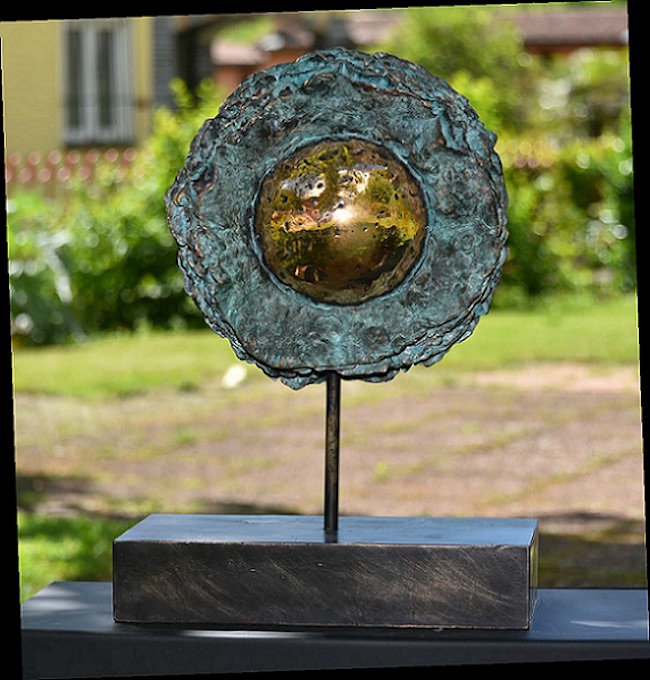
Le sfere della Mucchiani-Farah non sono chiuse, i volumi non sono pieni come quelli di Moore bensì sono vuote all’interno per suggerire quanto ogni evento vada a riempire quel vuoto, di volta in volta, di emozioni, sensazioni e interazioni con chiunque entri in contatto con l’individuo arricchendone il percorso personale.
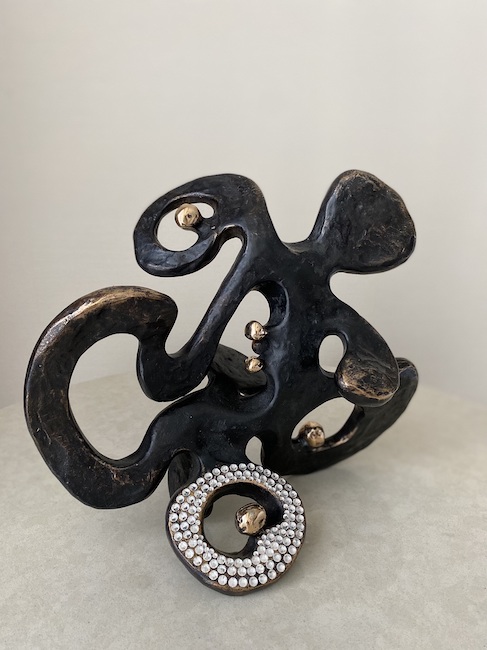
L’esperienza di vita, il costante muoversi per conoscere se stessa e per aprirsi a tutto ciò che l’esistenza le offre inducono l’artista ad avere un atteggiamento positivo, gioioso e aperto alla vita e alle esperienze che ne fanno parte, consapevole che persino la circostanza apparentemente meno piacevole possa in qualche modo racchiudere in sé il seme della crescita. Il bronzo è il materiale con cui ama di più misurarsi, materiale che lavora e modifica sulla base delle sensazioni che desidera esprimere e dunque a volte è più levigato, altre più sfaccettato, altre ancora ruvido.
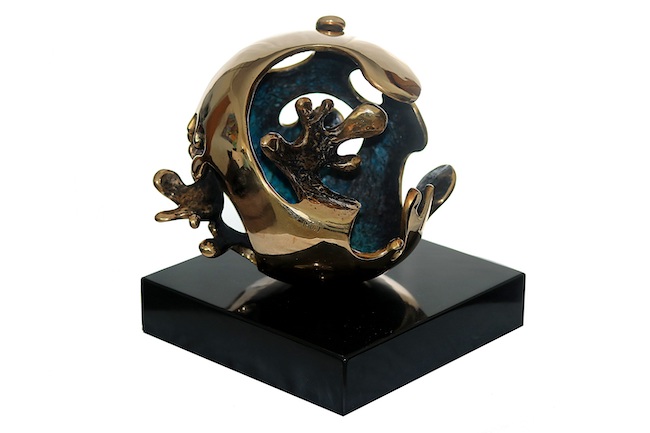
In Joy (Gioia) la superficie della sfera è perfettamente liscia, quasi come se la sensazione di felicità, di gioia descritta dal titolo riuscisse a infondere piacevolezza e serenità, senza alcun ostacolo al sorriso e alla leggerezza; le forme irregolari che interrompono la rotondità della sfera sono vivaci, vitali, sembrano in costante movimento teso a coinvolgere l’esterno, a comunicare quanta bellezza si nasconda dietro una sensazione semplice eppure in grado di trasformare tutto ciò che la circonda.
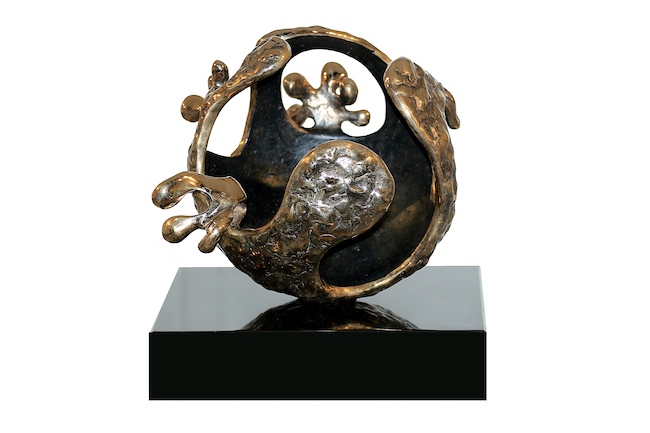
Nella scultura Feelings (Sentimenti) la superficie è meno levigata, come se la Mucchiani-Farah volesse porre l’attenzione su quanto a volte le relazioni siano complesse e composte di angoli da smussare, di contrasti da oltrepassare e da conflitti da sanare prima di raggiungere quell’armonia che permette alle due parti di una coppia di essere in perfetta sintonia malgrado le differenze; oppure, vista da un’altra angolazione, la sfera ruvida può rappresentare il percorso accidentato fatto di incontri e di persone che entrano ed escono dall’esistenza prima di raggiungere l’unica con cui continuare a camminare per il resto della vita. Le curve identificano le salite e le discese delle emozioni, ma la sfera in questo caso racconta di un destino che si compie, un circolo karmico che giunge alla sua realizzazione nel completamento con l’altro.
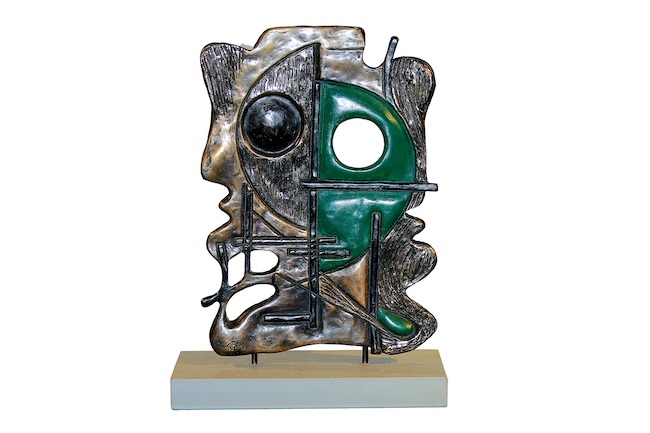
In Harmony of shapes in green (Armonia di forme in verde) invece l’artista abbandona la forma sferica per avvicinarsi a uno stile a metà tra il cubista e il surrealista, prendendo come riferimento le sculture di Joan Mirò e avvicinandosi anche al colore che diviene così evidenziante di un dettaglio, di un frammento di immagine in cui i vuoti si alternano ai pieni confermando la tendenza di Tiziana Mucchiani-Farah a intendere l’esistenza come un viaggio meraviglioso e sorprendente in cui l’avvicendarsi degli eventi costituisce un punto di fine ma anche di inizio di tutto ciò che verrà dopo; l’armonia è dunque da ricercarsi nella disarmonia, nello scontro di forme e di spazi che solo dopo uno sforzo di accettazione si può comprendere nel suo senso profondo, quel saper apprezzare la diversità e l’apparente difformità come un’evoluzione, una fuoriuscita dal guscio di sicurezze da cui spesso ci si avvolge e che in realtà immobilizza.
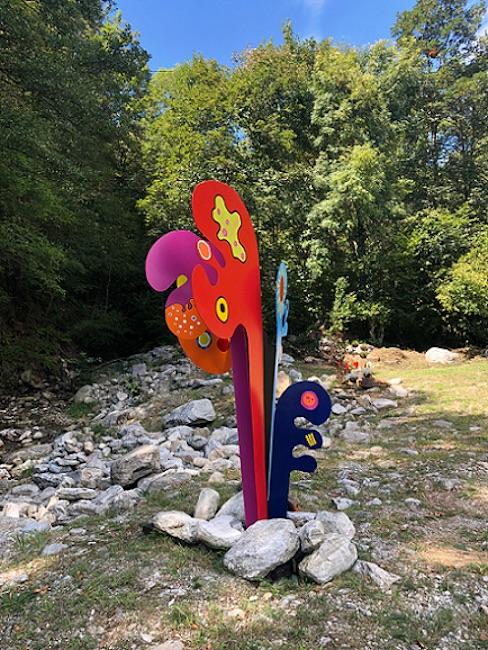
Le opere concepite per l’esterno confermano l’inclinazione al dialogo, all’interazione, della Mucchiani-Farah che in questo caso rinuncia alla colorazione quasi monocroma del bronzo per abbracciare il colore, le tonalità forti, intense, piene, tanto care proprio a Mirò e che consentono alla scultura di fuoriuscire, di porsi in evidenza pur riuscendo ad armonizzarsi perfettamente con l’ambiente circostante, lasciando che la voce comunicativa si espanda e conquisti l’osservatore.
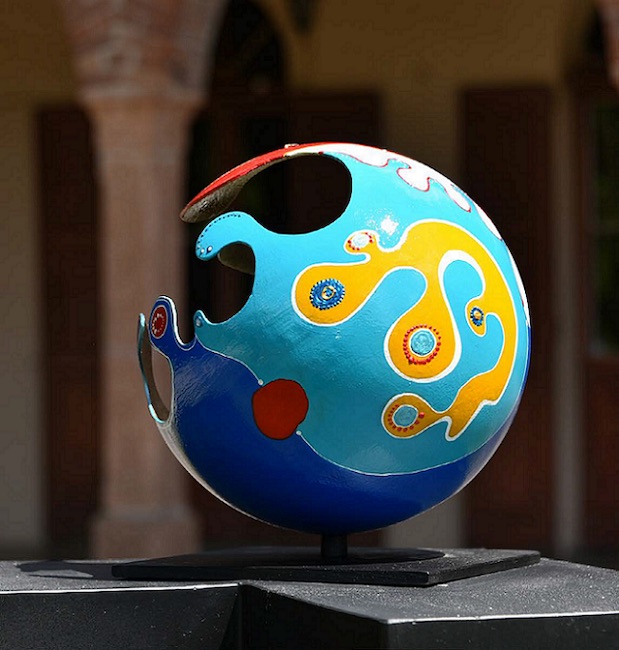
È questo il caso della scultura Conversazione astratta in cui il globo, e qui si torna alla forma sferica tanto cara all’artista, si arricchisce di forme variopinte che sembrano essere domande, interrogativi molto simili a quelli che l’individuo nasconde dentro se stesso per timore di scoprirne la risposta; l’Astrattismo permette ai quesiti di restare ermetici malgrado la vivacità delle tonalità scelte, sintomo che in qualche modo la necessità di fuoriuscire si fa più impellente, più urgente poiché la curiosità, il bisogno di dialogare è divenuta più forte del timore di porre le domande restando in silenzio.
Nel corso della sua carriera Tiziana Mucchiani-Farah ha partecipato a numerose mostre collettive in Italia, Svizzera, a Doha in Qatar, a Londra, Regno Unito, ricevendo l’apprezzamento di pubblico ed esperti d’arte.
TIZIANA MUCCHIANI-FARAH-CONTATTI
Email: tmucchiani@gmail.com
Sito web: www.tizianamucchiani.art
Facebook: https://www.facebook.com/tiziana.mucchianifarah
Instagram: https://www.instagram.com/mucchianifarah/
The sphere as a symbol of the circularity of existence in MuiT-Tiziana Mucchiani-Farah’s sculptures
Contemporary artists have the tendency to explore the interiority and depths of the soul with an intimist, existential approach, quite different from the need to let emotions flow out in an impetuous, overwhelming manner that characterised the masters of the previous century, when the need to affirm the predominance of sensations over form became urgent. In the current period, however, that urgency has been overtaken by an awareness of expressive freedom that belongs to our century, and so the artistic manifestation is equally intense but more measured, more conscious and balanced. Today’s protagonist spontaneously expresses her own concept of present-day living, of interchange and empathic strength through sculpture.
The profound stylistic changes that shook the artistic panorama in the first half of the twentieth century, often clearly breaking with the patterns of the past, could not fail to involve sculpture as well, which in turn has been linked to the various currents that have followed one another, leaving a profound mark in the way of meaning and making art, although the major exponents of the sculptural world have been able to maintain a strong originality, in fact reinterpreting the most incisive guidelines of painting. Starting with Primitivism, artists began to explore a different way of sculpting, taking inspiration from African and Asian masks and icons that formed the basis of Pablo Picasso’s Cubism but also of Amedeo Modigliani’s sculptures; Futurism also had its plastic icons with Umberto Boccioni whose Forme uniche nella continuità dello spazio (Unique shapes in the continuity of space) remains indissolubly identified as a symbol of the artistic movement he represented. Surrealism also had in Max Ernst an original interpreter, author of large figures with a tendentially rectangular shape in which the world of nightmare, of the disquieting, was narrated and placed in dialogue with the external environment. With the advent of Abstractionism, with the renunciation of everything that was knowable by the eye, the world of sculpture moved towards an absolute personalisation on the basis of feeling and understanding, rejecting form to enter the sphere of the intuitable, the perceptible or the concept of each artist; this is why the three major representatives of sculptural Abstractionism appear so different from each other.
The stylisation of form carried out by Constantin Bràncusi, whose images somehow seem to tell of the need to reduce appearance to the essential in order to go in search of being, of that contact with interiority without being distracted by everything that surrounds man and distances him from substance, expresses a stylistic search for perfection and purity of form that is linked to his philosophy, to his view of the world in which he lived. Just as much as Henry Moore instead reveals an harmonious need, divided between a more figurative and abstract approach, based on the feelings he wishes to represent, in which the rounded, soft figure in accord with its surroundings seems to suggest a search for, or rather an attempt to mediate between interiority and exteriority which, in his case, does not distance him from emotions and feelings; on the contrary, he seems to welcome and protect them within his aesthetic appearance. The Italian artist Tiziana Mucchiani-Farah, who has lived in Switzerland for many years, and whose Aka is MuiT, takes up the theme of Moore’s rounded forms, personalising them in an entirely original way, placing them at the centre of her sculptural research precisely to underline the understanding of the circularity of existence, of the awareness of how each experience has a specific meaning that leads to the next, inducing human beings to close the circle of their own evolution. The spheres of the Mucchiani-Farah are not closed, the volumes are not full like Moore’s ones but are empty inside to suggest how each event fills that void, time after time, with emotions, sensations and interactions with whoever comes into contact with the individual, enriching the personal journey.
The experience of life, the constant movement to get to know herself and to open up to everything existence has to offer induces the artist to have a positive, joyful and open attitude to life and the experiences that are part of it, aware that even the apparently least pleasant circumstance can in some way contain the seed of growth. Bronze is the material she most likes to measure herself with, a material she works with and modifies on the basis of the sensations she wishes to express, and is therefore sometimes smoother, sometimes more faceted, and sometimes rougher. In Joy, the surface of the sphere is perfectly smooth, almost as if the sensation of happiness, of joy described by the title, were able to instil pleasantness and serenity, without any obstacle to smiling and lightness; the irregular shapes that interrupt the roundness of the sphere are lively, vital, and seem to be in constant movement aimed at involving the outside world, at communicating how much beauty is hidden behind a simple sensation that is nevertheless capable of transforming everything around it. In the sculpture Feelings the surface is less polished, as if Mucchiani-Farah wanted to draw attention to how complex relationships can sometimes be, with corners to blunt, contrasts to be overcome and conflicts to be healed before reaching the harmony that allows the two parts of a couple to be in perfect harmony despite their differences; or, seen from another angle, the rough sphere can represent the bumpy path made up of encounters and people coming in and out of existence before reaching the one with whom one can continue to walk for the rest of his life. The curves identify the ups and downs of emotions, but the sphere in this case tells of a destiny that is fulfilled, a karmic circle that reaches its achievement in the completion with the other. In Harmony of shapes in green, on the other hand, the artist abandons the spherical form to approach a style somewhere between Cubist and Surrealist, taking Joan Mirò’s sculptures as a reference and also approaching colour, which thus becomes the highlight of a detail, of a fragment of an image in which empty spaces alternate with full ones, confirming Tiziana Mucchiani-Farah’s tendency to see existence as a marvellous and surprising journey in which the succession of events constitutes an end point but also the beginning of everything that will come after; harmony is therefore to be found in disharmony, in the clash of forms and spaces, which can only be understood in its deepest sense after an effort of acceptance, that of being able to appreciate diversity and apparent dissimilarity as an evolution, a breaking out of the shell of security by which we are often wrapped and in which reality immobilises us.
The artworks conceived for the outdoors confirm Mucchiani-Farah’s inclination towards dialogue and interaction, and in this case she renounces the almost monochrome colouring of bronze to embrace colour, the strong, intense, full tones so dear to Mirò and which allow the sculpture to emerge, to stand out while managing to harmonise perfectly with the surrounding environment, letting the communicative voice expand and conquer the observer. This is the case in the sculpture Abstract Conversation in which the globe – and here we return to the spherical form so dear to the artist – is enriched with multicoloured shapes that seem to be questions, interrogations very similar to those that the individual hides inside himself for fear of discovering the answer; Abstractionism allows the questions to remain hermetic despite the liveliness of the tones chosen, a symptom that in some way the need to escape becomes more impelling, more urgent, since curiosity, the need for dialogue, has become stronger than the fear of asking questions in silence. In the course of her career, Tiziana Mucchiani-Farah has participated in numerous group exhibitions in Italy, Switzerland, Doha in Qatar, London in the United Kingdom, receiving the appreciation of the public and art experts.


